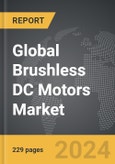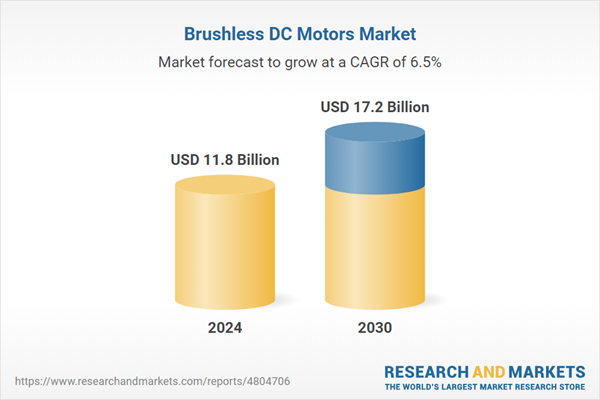The global market for Brushless DC Motors was valued at US$11.8 Billion in 2024 and is projected to reach US$17.2 Billion by 2030, growing at a CAGR of 6.5% from 2024 to 2030. This comprehensive report provides an in-depth analysis of market trends, drivers, and forecasts, helping you make informed business decisions. The report includes the most recent global tariff developments and how they impact the Brushless DC Motors market.
Segments: Type (Inner Rotor, Outer Rotor); End-Use (Manufacturing, Automotive, Medical Devices, Consumer Electronics, Other End-Uses).
Geographic Regions/Countries: World; United States; Canada; Japan; China; Europe (France; Germany; Italy; United Kingdom; Spain; Russia; and Rest of Europe); Asia-Pacific (Australia; India; South Korea; and Rest of Asia-Pacific); Latin America (Argentina; Brazil; Mexico; and Rest of Latin America); Middle East (Iran; Israel; Saudi Arabia; United Arab Emirates; and Rest of Middle East); and Africa.
The analysts continuously track trade developments worldwide, drawing insights from leading global economists and over 200 industry and policy institutions, including think tanks, trade organizations, and national economic advisory bodies. This intelligence is integrated into forecasting models to provide timely, data-driven analysis of emerging risks and opportunities.
Global Brushless DC Motors Market - Key Trends and Drivers Summarized
What Makes Brushless DC Motors Stand Out in the Market?
Brushless DC motors (BLDC) have rapidly emerged as a preferred choice in numerous industries due to their superior performance characteristics compared to traditional brushed motors. The key differentiator is their design; BLDC motors do away with the brushes that are essential in conventional motors, replacing them with electronic controllers for commutation. This eliminates the issues of friction and wear associated with brushes, significantly enhancing the motor’s durability and reducing maintenance requirements. This fundamental shift in design allows BLDC motors to deliver highly efficient performance over longer periods, with much greater precision in controlling speed and torque. Industries such as automotive, aerospace, HVAC, and industrial automation have embraced BLDC motors because of these advantages, particularly in environments where reliability and operational efficiency are critical. Moreover, with the growing emphasis on energy efficiency across global industries, BLDC motors offer a substantial reduction in energy consumption, making them a highly attractive option in sectors where energy usage needs to be minimized to meet stringent regulatory standards. This combination of low maintenance, high efficiency, and operational precision has propelled BLDC motors to the forefront of motor technology in recent years.How Are Technological Advancements Shaping the Future of Brushless DC Motors?
The rapid development of technology has been pivotal in shaping the evolution and adoption of BLDC motors. Advances in semiconductor technology, power electronics, and control algorithms have allowed manufacturers to improve motor efficiency, enhance control precision, and expand their application in more complex systems. Modern BLDC motors are increasingly being paired with sophisticated electronic controllers, enabling smoother and more flexible speed control, higher power output, and reduced operational noise. These controllers, often powered by advanced microprocessors, enable dynamic adjustments in real-time, leading to more optimized and efficient motor performance, especially in industries that require precise motion control, such as robotics and automation. Another significant trend is the integration of Internet of Things (IoT) technologies and smart sensors within BLDC motors. This integration allows for remote monitoring, predictive maintenance, and advanced diagnostics, enabling industries to prevent downtime and optimize performance. Additionally, the push towards miniaturization in electronics has allowed for the creation of smaller, more compact BLDC motors without sacrificing power or efficiency. These motors are now used in an ever-expanding range of applications, from compact consumer electronics to highly specialized industrial tools, showcasing their versatility and adaptability in the evolving landscape of motor technology.Why Is Consumer Demand Shifting Toward Brushless DC Motors?
The surge in demand for BLDC motors is largely a reflection of changing consumer behaviors and the evolving priorities of industries. As both individuals and organizations become more environmentally conscious, there is a growing preference for technologies that reduce energy consumption and environmental impact. BLDC motors, known for their high energy efficiency, have become particularly attractive in this regard. In sectors such as automotive, the transition to electric vehicles (EVs) is perhaps the most notable example of this shift. BLDC motors play an essential role in the performance of EVs, as they offer high efficiency and low maintenance, which in turn improves battery life and vehicle range, two critical factors for the success of electric mobility. In the consumer appliance sector, the shift toward quieter, more durable, and energy-efficient products has driven a marked increase in the use of BLDC motors in devices like air conditioners, refrigerators, washing machines, and even vacuum cleaners. These motors help meet the growing consumer demand for appliances that not only last longer but also operate more quietly and efficiently, enhancing overall user experience. At the same time, government incentives and energy regulations are encouraging businesses and consumers alike to adopt energy-efficient technologies, making BLDC motors an even more attractive choice in both residential and commercial settings.What Is Driving the Growth of the Brushless DC Motor Market?
The growth in the BLDC motor market is driven by several factors, most notably the increasing demand for energy efficiency and performance optimization in key industries. As global energy concerns escalate, manufacturers are under pressure to design and implement motors that consume less power without compromising on output. This need for efficiency is particularly pronounced in industries like automotive, where the rise of electric vehicles has created a significant demand for high-performance motors that can extend battery life and improve vehicle efficiency. BLDC motors, known for their low energy consumption and minimal maintenance requirements, are proving to be ideal for this application. Similarly, industrial automation is driving the adoption of BLDC motors in robotics, CNC machines, and other equipment that require precise, reliable, and efficient motion control. The ability of BLDC motors to deliver high torque and precise speed control makes them indispensable in these applications. In the consumer market, the increasing popularity of smart appliances is spurring demand for quieter, more efficient motors, with BLDC motors meeting the expectations of today’s energy-conscious consumers. Furthermore, the healthcare sector has also become a significant market for BLDC motors, particularly in medical devices like ventilators and surgical robots, where precision, reliability, and quiet operation are critical. Lastly, government policies promoting energy-efficient technologies, combined with tax incentives for manufacturers and consumers who adopt such solutions, are further fueling market growth, making BLDC motors a cornerstone of modern energy-saving initiatives.Report Scope
The report analyzes the Brushless DC Motors market, presented in terms of units. The analysis covers the key segments and geographic regions outlined below.Segments: Type (Inner Rotor, Outer Rotor); End-Use (Manufacturing, Automotive, Medical Devices, Consumer Electronics, Other End-Uses).
Geographic Regions/Countries: World; United States; Canada; Japan; China; Europe (France; Germany; Italy; United Kingdom; Spain; Russia; and Rest of Europe); Asia-Pacific (Australia; India; South Korea; and Rest of Asia-Pacific); Latin America (Argentina; Brazil; Mexico; and Rest of Latin America); Middle East (Iran; Israel; Saudi Arabia; United Arab Emirates; and Rest of Middle East); and Africa.
Key Insights:
- Market Growth: Understand the significant growth trajectory of the Inner Rotor segment, which is expected to reach US$10.1 Billion by 2030 with a CAGR of a 6.2%. The Outer Rotor segment is also set to grow at 7.0% CAGR over the analysis period.
- Regional Analysis: Gain insights into the U.S. market, valued at $3.1 Billion in 2024, and China, forecasted to grow at an impressive 10.5% CAGR to reach $3.9 Billion by 2030. Discover growth trends in other key regions, including Japan, Canada, Germany, and the Asia-Pacific.
Why You Should Buy This Report:
- Detailed Market Analysis: Access a thorough analysis of the Global Brushless DC Motors Market, covering all major geographic regions and market segments.
- Competitive Insights: Get an overview of the competitive landscape, including the market presence of major players across different geographies.
- Future Trends and Drivers: Understand the key trends and drivers shaping the future of the Global Brushless DC Motors Market.
- Actionable Insights: Benefit from actionable insights that can help you identify new revenue opportunities and make strategic business decisions.
Key Questions Answered:
- How is the Global Brushless DC Motors Market expected to evolve by 2030?
- What are the main drivers and restraints affecting the market?
- Which market segments will grow the most over the forecast period?
- How will market shares for different regions and segments change by 2030?
- Who are the leading players in the market, and what are their prospects?
Report Features:
- Comprehensive Market Data: Independent analysis of annual sales and market forecasts in US$ Million from 2024 to 2030.
- In-Depth Regional Analysis: Detailed insights into key markets, including the U.S., China, Japan, Canada, Europe, Asia-Pacific, Latin America, Middle East, and Africa.
- Company Profiles: Coverage of players such as Allied Motion Technologies, Inc., AMETEK, Inc., Anaheim Automation, Inc., ARC Systems, Inc., Buhler Motor GmbH and more.
- Complimentary Updates: Receive free report updates for one year to keep you informed of the latest market developments.
Some of the 11 companies featured in this Brushless DC Motors market report include:
- Allied Motion Technologies, Inc.
- AMETEK, Inc.
- Anaheim Automation, Inc.
- ARC Systems, Inc.
- Buhler Motor GmbH
- ElectroCraft, Inc.
- Fortive Corporation
- Johnson Electric Group
- Maxon Motor AG
- Minebea Co., Ltd.
- MOONS' Electric Co., Ltd.
- Nidec Corporation
- Oriental Motor Co., Ltd.
- Shinano Kenshi Corporation
- Zhejiang Linix Motor Co. Ltd
Tariff Impact Analysis: Key Insights for 2025
Global tariff negotiations across 180+ countries are reshaping supply chains, costs, and competitiveness. This report reflects the latest developments as of April 2025 and incorporates forward-looking insights into the market outlook.The analysts continuously track trade developments worldwide, drawing insights from leading global economists and over 200 industry and policy institutions, including think tanks, trade organizations, and national economic advisory bodies. This intelligence is integrated into forecasting models to provide timely, data-driven analysis of emerging risks and opportunities.
What’s Included in This Edition:
- Tariff-adjusted market forecasts by region and segment
- Analysis of cost and supply chain implications by sourcing and trade exposure
- Strategic insights into geographic shifts
Buyers receive a free July 2025 update with:
- Finalized tariff impacts and new trade agreement effects
- Updated projections reflecting global sourcing and cost shifts
- Expanded country-specific coverage across the industry
Table of Contents
I. METHODOLOGYII. EXECUTIVE SUMMARY2. FOCUS ON SELECT PLAYERSIII. MARKET ANALYSISSOUTH KOREAREST OF ASIA-PACIFICARGENTINABRAZILMEXICOREST OF LATIN AMERICAIRANISRAELSAUDI ARABIAUNITED ARAB EMIRATESREST OF MIDDLE EASTIV. COMPETITION
1. MARKET OVERVIEW
3. MARKET TRENDS & DRIVERS
4. GLOBAL MARKET PERSPECTIVE
UNITED STATES
CANADA
JAPAN
CHINA
EUROPE
FRANCE
GERMANY
ITALY
UNITED KINGDOM
SPAIN
RUSSIA
REST OF EUROPE
ASIA-PACIFIC
AUSTRALIA
INDIA
LATIN AMERICA
MIDDLE EAST
AFRICA
Companies Mentioned (Partial List)
A selection of companies mentioned in this report includes, but is not limited to:
- Allied Motion Technologies, Inc.
- AMETEK, Inc.
- Anaheim Automation, Inc.
- ARC Systems, Inc.
- Buhler Motor GmbH
- ElectroCraft, Inc.
- Fortive Corporation
- Johnson Electric Group
- Maxon Motor AG
- Minebea Co., Ltd.
- MOONS' Electric Co., Ltd.
- Nidec Corporation
- Oriental Motor Co., Ltd.
- Shinano Kenshi Corporation
- Zhejiang Linix Motor Co. Ltd
Table Information
| Report Attribute | Details |
|---|---|
| No. of Pages | 229 |
| Published | April 2025 |
| Forecast Period | 2024 - 2030 |
| Estimated Market Value ( USD | $ 11.8 Billion |
| Forecasted Market Value ( USD | $ 17.2 Billion |
| Compound Annual Growth Rate | 6.5% |
| Regions Covered | Global |









